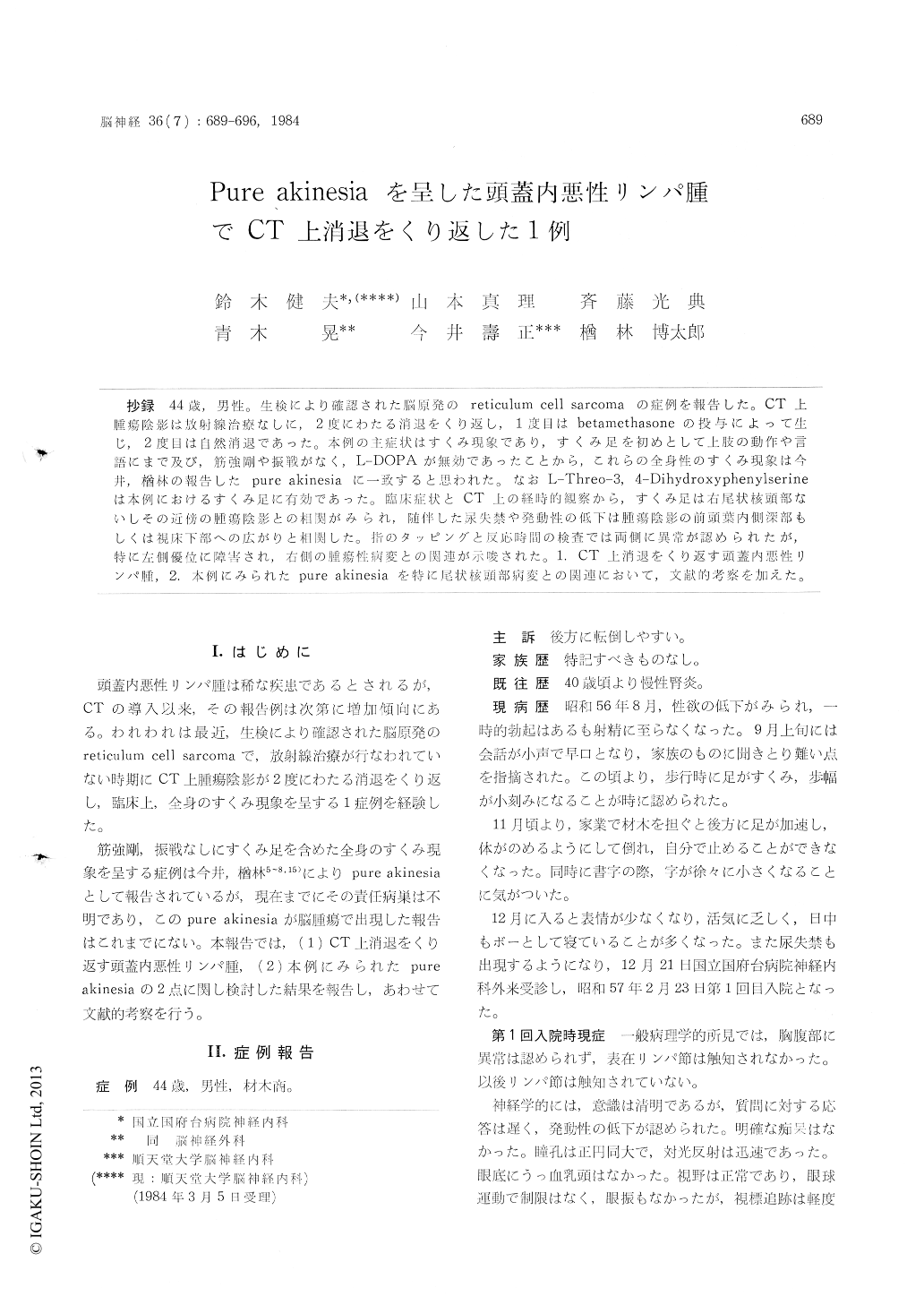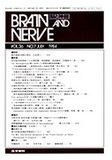Japanese
English
- 有料閲覧
- Abstract 文献概要
- 1ページ目 Look Inside
抄録 44歳,男性。生検により確認された脳原発のreticulum cell sarcomaの症例を報告した。CT上腫瘍陰影は放射線治療なしに,2度にわたる消退をくり返し,1度目はbetamethasoneの投与によって生じ,2度目は自然消退であった。本例の主症状はすくみ現象であり,すくみ足を初めとして.上肢の動作や言語にまで及び,筋強剛や振戦がなく,L-DOPAが無効であったことから,これらの全身性のすくみ現象は今井,楢林の報告したpure akinesiaに一致すると思われた。なおL-Threo−3,4—Dihydroxyphenylserineは本例におけるすくみ足に有効であった。臨床症状とCT上の経時的観察から,すくみ足は右尾状核頭部ないしその近傍の腫瘍陰影との相関がみられ,随伴した尿失禁や発動性の低下は腫瘍陰影の前頭葉内側深部もしくは視床下部への広がりと相関した。指のタッピングと反応時間の検査では両側に異常が認められたが,特に左側優位に障害され,右側の腫瘍性病変との関連が示唆された。1.CT上消退をくり返す頭蓋内悪性リンパ腫,2.本例にみられたpure akinesiaを特に尾状核頭部病変との関連において,文献的考察を加えた。
In a case of primary reticulum cell sarcoma in the brain, histologically verified by biopsy, the tumor regressed twice on a CT scan without radiotherapy. The systemic freezing phenomenon was seen as a main clinical symptom.
The patient, a 44 year-old male, first complained of decreased livido and festinating speech. He also showed frozen gait, micrographia, a decrease in spontaneity and urinary incontinence. Four months after onset he was hospitalized. Neurolo-gical findings on admission revealed freezing ofgait,writing, and speech, but there was no weak-ness of muscles with normal tendon reflexes, and normal muscular tone.
In the CT scan on admission, there were high density areas mainly in the head of the right caudate nucleus, the medial deep portion of the right frontal lobe, the right side of the hypo-thalamus, the anterior thalamus, the globus pallidus. There were also nodular-type enhanced effects in the same areas.Regression of the tumor was seen on the CT scans after administration of betamethasone. The tumor which had again in-creased in size regressed spontaneously without the use of steroids after 3 months. Thereafter, the tumor gradually became larger and an open biopsy was perfomed. Histopathological findings showed a reticulum cell sarcoma. There were no findings of systemic malignant lymphoma. Such intracrainal malignant lymphomas showing repeated regression including spontaneous one are very rare in the literature.
The freezing phenomenon in this case started with festinating speech and spread to writing and gait. L-DOPA had no effect. This systemic freez-ing phenomenon was considered to be the same as that in the cases of pure akinesia without rigidity and tremor reported by Narabayashi and Imai, which did not respond to L-DOPA at all. But on the other hand, L-Threo-3, 4-Dihydro-xyphenylserine was effective to the frozen gait of this patient.
From the clinical symptoms and repeated CT examinations, it was suggested that the frozen gait was related to the lesion in the head of the right caudate nucleus or its around areas on CT scans, while the urinary incontinence and decrease in spontaneity were related to the spread of the tumor into the medial deep portion of the frontal lobe or into the hypothalamus.
In the finger tapping test, the hastening pheno-menon described by Nakamura et al was seen on both sides, predominantly on the left side. With respect to the reaction time, there was prolongation of both the initiation and movement times on both sides, and there was a remarkable extension of the initiation time on the left side. The predo-minance of these disturbances of the left side suggested that the freezing phenomenon is closely related to the tumor lesion seen on the right side of the brain.
There have been no reports of pure akinesia due to the brain tumor, and the localized area of pathology responsible for this specific symptom has not been presented. The present case may suggest the important role of the head of caudate nucleus or its adjacent structures in generation of freezing symptoms.

Copyright © 1984, Igaku-Shoin Ltd. All rights reserved.


